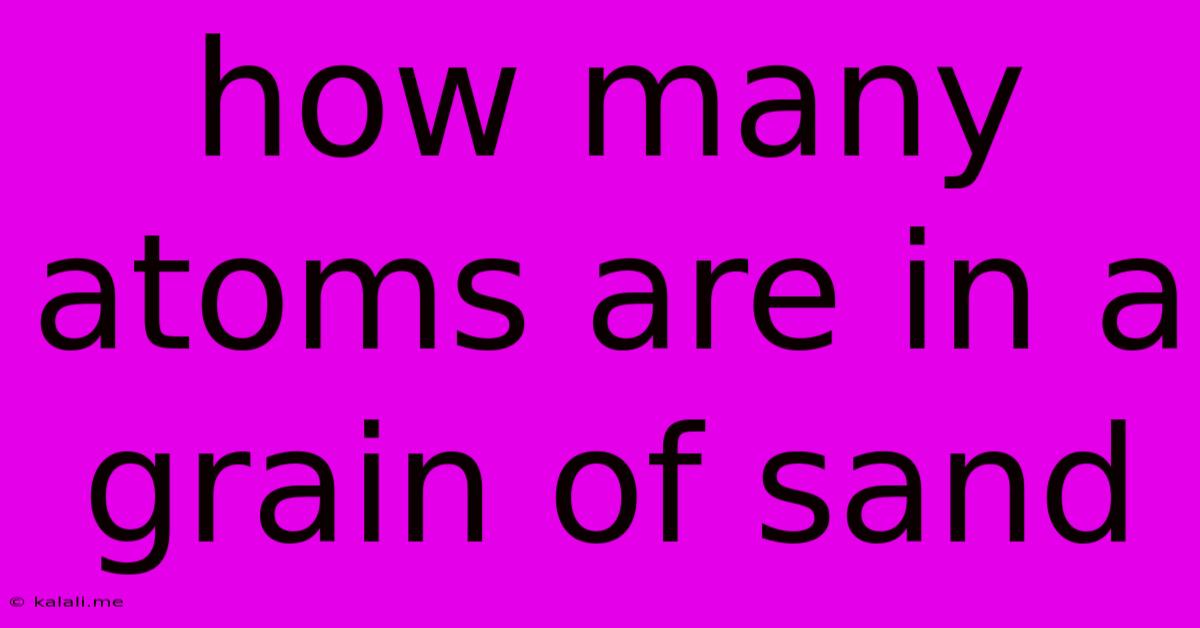How Many Atoms Are In A Grain Of Sand
Kalali
May 22, 2025 · 3 min read

Table of Contents
How Many Atoms Are in a Grain of Sand? A Deep Dive into the Microscopic World
Meta Description: Ever wondered about the sheer number of atoms in a seemingly insignificant grain of sand? This article delves into the fascinating world of atomic scale, exploring the calculations and estimations involved in determining this microscopic magnitude. Discover the surprising answer and learn about the composition of sand.
A grain of sand, seemingly insignificant and commonplace, holds within it a staggering number of atoms. But how many exactly? This seemingly simple question opens a window into the vastness of the microscopic world and the power of scientific estimation. Let's explore the journey to finding an answer.
Understanding the Composition of Sand
Before we embark on the calculation, it's crucial to understand what sand is primarily made of. While the exact composition varies based on location and geological history, sand predominantly consists of silicon dioxide (SiO2), also known as quartz. This means the majority of atoms in a grain of sand are silicon and oxygen atoms. Other minerals, like feldspar and calcite, might contribute a smaller percentage of atoms.
Estimating the Size of a Grain of Sand
To calculate the number of atoms, we need an estimate of the size of a grain of sand. Sand grains vary significantly in size, generally ranging from 0.0625 mm to 2 mm in diameter. For the sake of our calculation, let's assume an average diameter of 0.5 mm or 5 x 10⁻⁴ meters. This translates to a spherical volume that we can calculate.
Calculating the Volume of a Grain of Sand
We can approximate the shape of a grain of sand as a sphere. The volume of a sphere is calculated using the formula: V = (4/3)πr³, where 'r' is the radius (half the diameter). With a diameter of 0.5 mm, the radius is 0.25 mm or 2.5 x 10⁻⁴ meters. Therefore, the volume is approximately 6.54 x 10⁻¹¹ cubic meters.
Determining the Number of SiO2 Molecules
The density of quartz is approximately 2,650 kg/m³. Using this density and the calculated volume, we can determine the mass of our average grain of sand. From the mass and the molar mass of SiO2 (approximately 60.08 g/mol), we can calculate the number of SiO2 molecules using Avogadro's number (6.022 x 10²³ molecules/mol). This requires several conversion steps and careful unit handling, ultimately yielding a substantial number of SiO2 molecules.
Calculating the Total Number of Atoms
Finally, each SiO2 molecule contains three atoms (one silicon and two oxygen). Therefore, the total number of atoms in our average grain of sand is three times the number of SiO2 molecules calculated in the previous step. This final calculation results in an astonishingly large number.
The Final Answer: A Mind-Boggling Number of Atoms
While the exact number will vary based on the size and composition of the grain of sand, the calculation reveals that a single grain of sand contains on the order of 10¹⁹ to 10²⁰ atoms. This is a number so large it's difficult to comprehend – a 1 followed by 19 or 20 zeros!
Conclusion: A Grain of Sand, a Universe Within
This exercise demonstrates the incredible scale of the atomic world. What appears as a tiny, insignificant speck of matter actually contains an unimaginably vast number of atoms. This microscopic universe within a grain of sand highlights the complexity and wonder of the natural world. Remember that this is an estimation, and the actual number can vary depending on the grain's exact size, composition and even its geological history. Nevertheless, the sheer magnitude of atoms involved remains awe-inspiring.
Latest Posts
Latest Posts
-
Can A Tiger Climb A Tree
May 22, 2025
-
How Long Do Space Marines Live
May 22, 2025
-
How Do You Switch Off Iphone 7
May 22, 2025
-
Getting Rid Of Mold On Bathroom Ceiling
May 22, 2025
-
Beer In The Freezer How Long
May 22, 2025
Related Post
Thank you for visiting our website which covers about How Many Atoms Are In A Grain Of Sand . We hope the information provided has been useful to you. Feel free to contact us if you have any questions or need further assistance. See you next time and don't miss to bookmark.